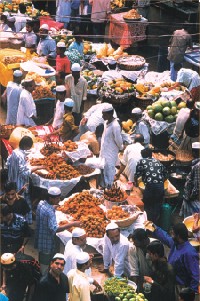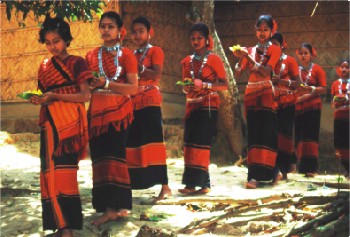 Eid
through ages
Eid
through ages
Eid-ul-Fitr
and Eid-ul-Azha are very significant among
all the Muslim festivals. These two religious
festivals are celebrated with much gaiety
in our country. Muslims, rich or poor wait
fervently for these two festivals. Eid-ul-Fitr
is closely associated with the month Ramadan
and fasting. It is also the holiest month
of the Muslims. Eid-ul-Azha also has a very
prominent aspect. It is closely related
with the custom of 'Haj' or pilgrimage.
Ramadan
is the only month of the Muslims, which
is mentioned, in holy Quran. It is the month
when Quran was revealed and Muhammad (SM)
received the first message. He also went
to 'Miraj' in this month.
Eid
was introduced in this continent after the
arrival of the Muslims. The Mughals who
were Muslims and lived in the northern parts
of India knew more about Islam than the
common people of Bengal. They were not very
interested in religious rites. According
to Islam, Eid is a time for happiness for
all, so they tried to bring about joy during
the month of Ramadan and on the day of Eid.
There
are almost no written forms about the celebration
of Eid in Bangladesh during or before the
advent of the Mughals. However, an account
of the Eid celebration among the common
people of Bangladesh can be found in the
book, Tabakat-i-Nasiri by historian Minah-us-Siraj.
He mentioned that Sultans used to arrange
discussions about religion affairs during
the month Ramadan. They appointed preachers
for the purpose and Imams to conduct namaj
of Eid. "The Eid congregations were
organised in the vast fields at the outskirts
of the city or in villages. These villages
were known as Eidgah".
The
oldest account of Eid in Bangladesh can
be found in Mirza Nathan's writings. He
writes, "In the evening, when the new
moon was observed the royal trumpet echoed.
The group of artillerymen fired blank shots
one after another as if they were fireworks.
Towards the end of the night the big canon
was fired which almost felt like an earthquake."
Apart
from a few books, we do not have much information
about the Eid before the previous century.
It is however easy to assume seeing the
remains of Eidgahs at different region (Dhaka,
Sylhet) that the Mughals gave much importance
to Eid. In Dhanmondi there still exists
one such Eidgah.
It
is contemplated by many that the existing
manners of celebration of these two festivals
in Bangladesh have been influenced by the
secular beliefs of the rural people. It
should be mentioned here that during the
Mughal rule only the members of the royal
family and the elite class went to the Eidgah.
The common men were not allowed to join
in. They incorporated secular elements in
to their celebration. On the day of Eid,
they arranged melas. This trend started
at the end of 18th century and during the
earliest years of 19th century. There is
however no account in any written forms
about these melas. In Chauk Bazar and Kamlapur,
fairs are still organised which are the
remnants of the fairs back then. Fairs were
organised outside Dhaka too. It is evident
from the list prepared by the Bangladesh
Small and Cottage Industries Corporation,
which says a minimum of about 12 fairs are
still organised in different parts of Bangladesh
on the day of Eid.
We
get another description of Eid celebration
in the villages during 1930s or 40s from
Khandokar Abu Talib. He wrote, "The
housewives started preparing many types
of country cakes with designs on them from
15th day of Roja. Among these, the jhuri,
handmade shemai are worth mentioning. The
ladies used to put on mehendi on their hands
on the night of Shab-e-Qadar. Flower cakes
were prepared to treat the young men and
women and friends on the day of Eid. There
used to be butterfly decorations on them.
Young married women used to write "dear
husband" on them and unmarried girls
wrote "marriage". The meeting
of Eid was looked forward to and was very
important in the matter of wedding of the
young men and women of the village. In those
days many problems were solved during the
religious festivals. Even lifelong enemy
used to forget enmity".
Eid
became a very important event from the beginning
of 19th century especially when the separation
movement of Muslims started. Grandeur of
the Eid celebration was mostly restricted
among the urban elites.
Both
the Eid have become national religious festivals
of Bangladesh after the creation of Pakistan
in 1947. From that time onwards Eid was
patronised by the state.
Nowadays,
the rich people of Bangladesh celebrate
Eid by buying new clothes, giving presents
and preparing special food. Many of the
nouveau elites go abroad on holidays. For
the ordinary people Eid means returning
home to loved ones from the hassles of city
life, getting new clothes for wife and children
from the footpath stores and arranging the
possible best dishes they can manage. The
festival now has different dimension from
back then. However, the foremost aspiration
is the same. It is all about harmony and
happiness.
.........................................................
Excerpts from the book The Festivals of
Bangladesh by Muntasir Mamun.
Festivities
in the hills
 A
winter festival is now the only carrier
of fading cultural heritage of one of the
world's most ancient communities, known
as Mros, in the southeastern part of Bandarban.
Trekking up the hills, one would be surprised
to find the Mros inhabiting the most remote
pockets of land, small hills or sometimes
near streams. Chiyachot, a winter festival
celebrated with the slaughter of cows and
dance, has been a religious practice of
the Mros. The Mros believe that God created
different religions for different societies,
and the responsibility to bring their religion
was given to a cow. They believe the cow
exhausted from a long journey, became hungry
and ate their holy book. Therefore the cow
must be punished in the most cruel manner,
hence the tradition of cow slaughter began
after an order from their leader.
A
winter festival is now the only carrier
of fading cultural heritage of one of the
world's most ancient communities, known
as Mros, in the southeastern part of Bandarban.
Trekking up the hills, one would be surprised
to find the Mros inhabiting the most remote
pockets of land, small hills or sometimes
near streams. Chiyachot, a winter festival
celebrated with the slaughter of cows and
dance, has been a religious practice of
the Mros. The Mros believe that God created
different religions for different societies,
and the responsibility to bring their religion
was given to a cow. They believe the cow
exhausted from a long journey, became hungry
and ate their holy book. Therefore the cow
must be punished in the most cruel manner,
hence the tradition of cow slaughter began
after an order from their leader.
THOSE
living in other parts of the country also
hold on to their traditions and customs
that date back hundreds of years. Garos
in Mymensingh celebrate one of their biggest
festivals called Wanna, a thanksgiving event
to their God in Winter through much pomp
and festivities. Hundreds of Garos from
the nearby areas join the celebrations.
WHILE
the Bangalees prepare for Pahela Boishakh,
the tribal community of the Chittagong Hill
Tracts get ready for Baishabi, a festival
unique to the people and their land. The
population living in the hill tracts mainly
comprise of the Chakma, Marma, Tanchanga
and Tripura people. Each tribe celebrate
the New Year in their distinctive ethnic
style. Tripura's celebrate Baishu, Marma's
observe the Shangraing, Tanchanga's call
it the Bishu and to the Chamka the celebration
is termed Bijhu. The indigenous people of
Bangladesh have been continuing with their
distinct tradition, no matter how strong
the outside influence was. These festivals
are not restricted to only a few of the
tribes, with the change of time, people
belonging to marginal tribes like Rakhaines
also celebrate the festival in a similar
way.
 Celebration
of Muharram
Celebration
of Muharram
The majority of Muslims
in Bangladesh being Sunnis who have little
connection with Muharram do not celebrate
the occasion with that much gusto. However
the Shia sect celebrate this event with
much enthusiasm.
During the Mughal rule who
were originally from Persia the Shia ideology
spread its influence on the cultural sphere
of some regions of the Indian subcontinent
especially in Hooghly, Murshidabad and Dhaka.
During Emperor Shahjan's
rule, to be more specific when Shah Shuja
was Subedar, many Shia families migrated
to Bengal mainly from Iran.
It is difficult to say when
exactly the celebration of Muharram began
in Bangladesh. In the seventeenth century
during the Mughal rule, it was celebrated
in a few areas but most likely it became
popular in the villages in the nineteenth
century. Although Muharram is a month of
mourning but in Bangladesh it altered a
little. It is a festival here as in Egypt.
In
the villages many puthis (story
told through songs) were composed about
the tragic incident in Karbala. Chanting
of these puthis is widely popular.
It may be a festival of Shias but people
from different communities also take part
in the festivity. For the Shias the reason
might be religious but for others it is
commemoration.
Today
the Muharram celebration is limited only
within Old Dhaka. In the morning of the
celebration day the main procession starts
from the Husaini Dalan. It marches through
the roads of Bakhshibazar, Azimpur, Purana
Paltan and ends at Dhanmondi Lake in the
afternoon. The Tazia is later immersed in
the lake.

